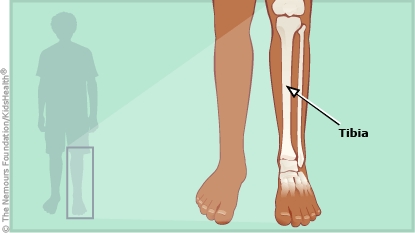Tibia Fracture and Cast: How to Care for Your Child
The tibia (also called the shinbone) is the larger of the two bones in the lower leg between the knee and the ankle. Your child has a cast to treat a fracture (break) in the bone. While the bone heals, the cast holds the bone in place.
Take care of the cast and treat pain as instructed to keep your child comfortable while the fracture heals.


-
To control swelling, for the first 2 days after the injury:
-
Use pillows to raise the cast above heart level when your child is sitting or lying down.
-
When your child is awake, put ice in a plastic bag wrapped in a towel on the outside of the cast for 20 minutes every 3 hours for up to 2 days. Don't put ice directly on the cast or skin.
-
Remind your child to stay off the leg until your health care provider says it's OK. If your child has crutches, make sure they use them safely.
-
Remind your child to wiggle the toes to keep blood flowing normally.
If your child has pain:
-
When your child is awake, apply ice in a plastic bag wrapped in a towel on the outside of the cast for 20 minutes every 3 hours for up to 2 days. Don't put ice directly on the cast or skin.
-
You can give medicine for pain if your health care provider says it's OK. Use these medicines exactly as directed:
-
acetaminophen (Tylenol® or a store brand)
-
OR
-
ibuprofen (Advil®, Motrin®, or a store brand). Do not give to babies under 6 months old.
Daily cast care:
-
Check the area around the cast every day. Make sure the skin isn't scratched and the toes aren't pale, blue, numb, or tingling.
-
Check the edges of the cast. Make sure your child isn't picking at or removing the padding from the edges.
-
Don't put anything in the cast. Make sure your child doesn't put toys, food, or anything else into it.
-
Keep dirt, sand, lotion, and powder away from the cast.
-
Keep the cast dry:
-
No swimming.
-
Give sponge baths to kids younger than 5 years old.
-
Older kids should take baths instead of showers.
-
Put a plastic covering over the cast when your child bathes. Put the leg and cast on something to keep them completely out of the water.
-
If the cast gets splashed with water, gently blow air into it from a hair dryer on the cool setting.
Problems to watch for:
-
Sharp cast edges: Put tape or moleskin (available at drugstores) on any rough spots.
-
Itching: Tap lightly on the cast or use a hair dryer on the cool setting to blow air in and around the edges.
-
Swelling: If the toes look puffy, raise the leg above the level of the heart for 1 hour. If the swelling doesn't get better, call your health care provider.
Be sure to:
-
Follow up with the orthopedic specialist as recommended.
-
Have your child avoid gym class, sports, and using playground equipment until the orthopedic specialist says it's OK.

Your child:
-
has pain that continues while taking pain medicine
-
has pain that gets worse
-
has a fever with no clear reason
-
has red or raw skin around the cast
-
has swollen toes even after raising the leg
-
feels the cast is too tight

-
Your child cannot wiggle the toes.
-
Your child has severe pain when moving the toes.
-
The foot or toes are pale or blue.
-
The cast is cracked or loose, gets wet, or smells bad.

How long does it take a tibia fracture to heal? Healing time varies, but kids with tibia fractures usually need a cast, splint, or brace for about 8–12 weeks. After the orthopedic specialist removes the cast, kids usually need to wear a brace while walking for a few weeks.